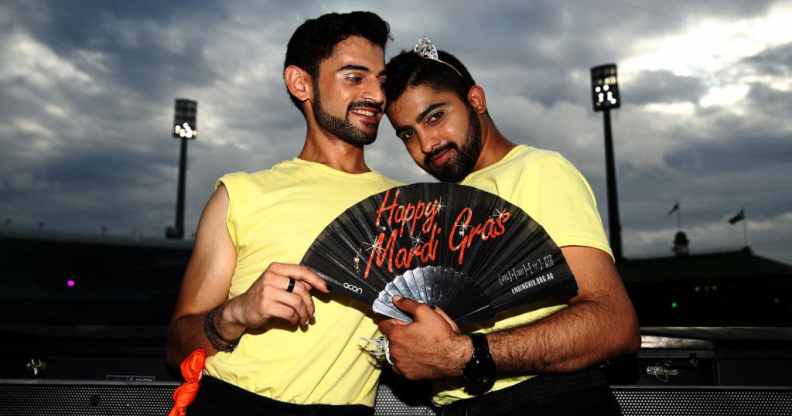Australia reveals how many same-sex weddings have taken place since marriage equality

Mardi Gras volunteers pose inside the Sydney Cricket Ground during the 44th Sydney Gay and Lesbian Mardi Gras Parade on March 05, 2022 in Sydney, Australia. (Photo by Don Arnold/Getty Images)
Nearly 24,000 same-sex marriages have been reported in the Australian 2021 census.
The Australian Bureau of Statistics (ABS) published the first round of results from its 2021 census, revealing that 23,914 same-sex marriages have taken place since marriage equality was legalised in 2017.
Sadly, this is about all the data on the LGBTQ+ population Australians can expect.
In August 2021, the Star Observer reported that the census would neglect to ask residents about gender identity or sexual orientation.
This was a result of the Scott Morrison-led government, which refused to acknowledge calls from LGBTQ+ organisations to add such questions.
The new data has reignited calls to better record LGBTQ+ people in the 2026 census, with advocacy groups asking the newly appointed Anthony Albanese led government to follow the examples of the UK, New Zealand, and Canada.
Equality Australia has always been vocal on the matter. Its CEO Anna Brown said: “The release of census data gives us fascinating insights into the diversity of the Australian community – what we believe, what language we speak at home, rates of chronic disease, and other key demographic data that will inform crucial decisions about what services are provided to communities, and where.
“But once again, lesbian, gay, bi+, transgender, intersex and queer people are not properly represented in the census data, because the ABS and the minister responsible at the time failed to ensure much-needed questions about sexual orientation, gender identity or variations in sex characteristics were asked or asked properly.”
She added: “Until we’re counted, we’ll remain invisible. That’s why – with the first release of 2021 census data – our communities are coming together again to say that it’s time for the census to stop leaving LGBTIQ+ people out, and count us in.”
Australian’s head statician Dr David Gruen has said that the diversity and changing structure of Australian families has also been highlighted by the census.
Gruen said that the latest findings “provides a fascinating glimpse into the structure and changing profile of Australian families”.
While the release gives a brief glimpse, it doesn’t show the number of LGBTQ+ couples not married.
The ABS 1996 census recorded over 10,000 same-sex couples; this marked the first time the number of same-sex relationships had been counted.
By the time the 2016 census was taken, that numbers had increased to 46,800 same-sex couples.
Not recording all LGBTQ+ individuals isn’t the only issue – census language has also been criticised.
For the first time on the Australian census, there was an option to select a non-binary gender.
However, Brown and other organisations have accused the language of being “confusing”, noting that it “conflated the trans and intersex population, and failed to count most trans people who identify as simply male or female”.
“The census seriously let down transgender, gender diverse and intersex people. It failed to ask questions that captured our true diversity, rendering most transgender and intersex people invisible or unable to accurately answer questions in the census which made assumptions about gender,” Brown posited.

